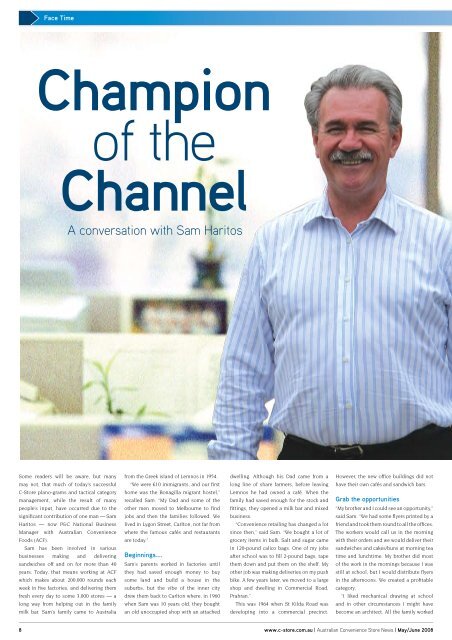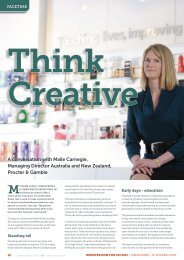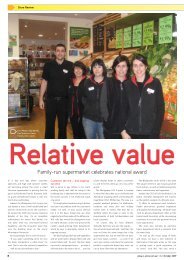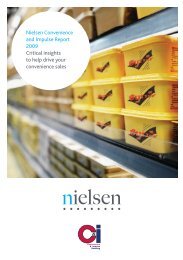HARITOS, Sam - Australian Convenience Foods (May/June 2008)
HARITOS, Sam - Australian Convenience Foods (May/June 2008)
HARITOS, Sam - Australian Convenience Foods (May/June 2008)
Create successful ePaper yourself
Turn your PDF publications into a flip-book with our unique Google optimized e-Paper software.
Face Time<br />
Champion<br />
of the<br />
Channel<br />
A conversation with <strong>Sam</strong> Haritos<br />
Some readers will be aware, but many<br />
may not, that much of today’s successful<br />
C-Store plano‐grams and tactical category<br />
management, while the result of many<br />
people’s input, have occurred due to the<br />
significant contribution of one man — <strong>Sam</strong><br />
Haritos — now P&C National Business<br />
Manager with <strong>Australian</strong> <strong>Convenience</strong><br />
<strong>Foods</strong> (ACF).<br />
<strong>Sam</strong> has been involved in various<br />
businesses making and delivering<br />
sandwiches off and on for more than 40<br />
years. Today, that means working at ACF<br />
which makes about 200,000 rounds each<br />
week in five factories, and delivering them<br />
fresh every day to some 3,000 stores — a<br />
long way from helping out in the family<br />
milk bar. <strong>Sam</strong>’s family came to Australia<br />
from the Greek island of Lemnos in 1954.<br />
“We were £10 immigrants, and our first<br />
home was the Bonagilla migrant hostel,”<br />
recalled <strong>Sam</strong>. “My Dad and some of the<br />
other men moved to Melbourne to find<br />
jobs and then the families followed. We<br />
lived in Lygon Street, Carlton, not far from<br />
where the famous cafés and restaurants<br />
are today.”<br />
Beginnings….<br />
<strong>Sam</strong>’s parents worked in factories until<br />
they had saved enough money to buy<br />
some land and build a house in the<br />
suburbs, but the vibe of the inner city<br />
drew them back to Carlton where, in 1960<br />
when <strong>Sam</strong> was 10 years old, they bought<br />
an old unoccupied shop with an attached<br />
dwelling. Although his Dad came from a<br />
long line of share farmers, before leaving<br />
Lemnos he had owned a café. When the<br />
family had saved enough for the stock and<br />
fittings, they opened a milk bar and mixed<br />
business.<br />
“<strong>Convenience</strong> retailing has changed a lot<br />
since then,” said <strong>Sam</strong>. “We bought a lot of<br />
grocery items in bulk. Salt and sugar came<br />
in 120-pound calico bags. One of my jobs<br />
after school was to fill 2-pound bags, tape<br />
them down and put them on the shelf. My<br />
other job was making deliveries on my push<br />
bike. A few years later, we moved to a large<br />
shop and dwelling in Commercial Road,<br />
Prahran.”<br />
This was 1964 when St Kilda Road was<br />
developing into a commercial precinct.<br />
However, the new office buildings did not<br />
have their own cafés and sandwich bars.<br />
Grab the opportunities<br />
“My brother and I could see an opportunity,”<br />
said <strong>Sam</strong>. “We had some flyers printed by a<br />
friend and took them round to all the offices.<br />
The workers would call us in the morning<br />
with their orders and we would deliver their<br />
sandwiches and cakes/buns at morning tea<br />
time and lunchtime. My brother did most<br />
of the work in the mornings because I was<br />
still at school, but I would distribute flyers<br />
in the afternoons. We created a profitable<br />
category.<br />
“I liked mechanical drawing at school<br />
and in other circumstances I might have<br />
become an architect. All the family worked<br />
<br />
www.c-store.com.au | <strong>Australian</strong> <strong>Convenience</strong> Store News | <strong>May</strong>/<strong>June</strong> <strong>2008</strong>
in the shop, and the focus was on family<br />
and the business.”<br />
<strong>Sam</strong>’s love of design and years of retail<br />
experience eventually found a creative<br />
outlet some years later when <strong>Sam</strong> was one<br />
of the first in the industry to experiment<br />
with tactical C-Store category layouts.<br />
Despite his parents’ efforts, after growing<br />
up in the milk bar business <strong>Sam</strong> was not<br />
that keen on staying and working in the<br />
family business. When he left school, he<br />
worked in the Department of Trade and<br />
Industry.<br />
“I was only there for 12 months,” said<br />
<strong>Sam</strong>. “It was clear that promotion was not<br />
based on merit, and I could not see much<br />
of a future there. I went back to work in the<br />
family store.<br />
“Dad had always been a bit of a risk<br />
taker, but he had faith in himself. He also<br />
understood retailing. He knew how to look<br />
after customers. We decided to branch<br />
out into a supermarket; partly in the hope<br />
of more reasonable working hours. After<br />
selling the Prahran store we bought another<br />
milk bar in St Kilda which my Mum and<br />
sister ran and we also purchased a small<br />
‘Foodland’ supermarket in outer suburban<br />
Eltham that Dad and I managed. By then,<br />
my older brother Con had moved back to<br />
Lemnos where he now has a BP service<br />
station. Even though supermarket hours<br />
were shorter, we still ended up doing long<br />
hours with all the ordering and paper work<br />
to do.<br />
“In 1970 we bought a bigger supermarket<br />
in McKinnon where there was strong<br />
competition from the big supermarket<br />
chains. We built the business by focussing<br />
on customer service. In those days, families<br />
only had one car and on the Thursday or<br />
Friday the husband would leave the car<br />
at home and take the train - and the wife<br />
would do the weekly shop. We would<br />
pack groceries in cardboard boxes and<br />
carry them out to the cars, chatting with<br />
customers and getting to know them. You<br />
did not get that sort of service at the big<br />
supermarkets.”<br />
<strong>Sam</strong> and Judy (they would later marry)<br />
decided to get some travelling in before<br />
they settled down.<br />
While living in London in 1974, <strong>Sam</strong><br />
worked in a sandwich shop at Waterloo<br />
Station churning out sandwiches at a<br />
frenetic pace. It sometimes seemed as if the<br />
entire population of London was queuing<br />
along the sidewalk waiting for such exotic<br />
delights as salmon and cream cheese; back<br />
home, ham cheese and tomato was still the<br />
norm.<br />
After nearly a year in Europe, they came<br />
home and needed to find work. <strong>Sam</strong> took<br />
on a supermarket manager’s job with<br />
Woolworths.<br />
“It was what I knew,” said <strong>Sam</strong>. “And, I<br />
needed a job. I was also good at it because<br />
I had such a deep understanding of the<br />
business. But, after a couple of years I<br />
wanted a new challenge and was keen to<br />
see the business from the supply side.”<br />
As is often the way with these things,<br />
while walking down the street <strong>Sam</strong> bumped<br />
into a former Uncle Ben’s rep, Terry<br />
Shannon, who had become state manager<br />
for the recently set up Mars Confectionery.<br />
Terry encouraged him to apply for a newlycreated<br />
reps’ jobs.<br />
Mars had just set up in Australia a couple<br />
of years earlier and they were looking for<br />
full-time confectionery sales people to<br />
develop their supermarket business. Terry<br />
put in a good word for me, and I started<br />
with Mars in 1979.<br />
Terry’s faith in <strong>Sam</strong> was more than<br />
vindicated when he won Salesman of the<br />
Year in his first year and again the next<br />
year based on only a few months’ sales!<br />
<strong>Sam</strong> worked through a number of account<br />
management roles and stayed with Mars<br />
for a total of 15 years.<br />
In 1991, as Mars’ National Account Manager, Traditional, <strong>Sam</strong> Haritos was interviewed for<br />
Shell’s Shop Talk - seeking his views on how to increase turnover through the use of a<br />
good confectionery layout. (Image reprinted from Shell Shop – Shop Talk Vol 2 no 3)<br />
New role creates win-win<br />
“Mars was a great company to work for,”<br />
recalled <strong>Sam</strong>. “They would encourage you<br />
to take on new challenges. I was given the<br />
opportunity I needed when they made<br />
me New Business Development Manager<br />
for the route trade. Part of the role was to<br />
revamp a couple of stores to test different<br />
confectionery layouts.<br />
We redesigned and refitted stores in<br />
Bendigo and Dandenong. I got a lot of<br />
satisfaction from helping store owners who<br />
were much like my parents. They were so<br />
focussed on the everyday running of the<br />
business that they did not have the time to<br />
sit back and rethink a single category.<br />
Mars paid for the new category layout<br />
and both stores were so successful that<br />
we published the results, and through<br />
similar exercises with the then fledging P&C<br />
industry I created my own role of petrol and<br />
convenience channel account manager.”<br />
That was the late 1980s when C-Stores<br />
were just starting to evolve from milk bars<br />
and service station shops. One of <strong>Sam</strong>’s<br />
earliest accounts was Caltex.<br />
“I recall one couple in a Caltex service<br />
station in Nunawading,” said <strong>Sam</strong>. “In<br />
conjunction with <strong>Convenience</strong> Store News<br />
we redesigned the layout of the store and<br />
as a result the store doubled its sales. They<br />
were thrilled with the results. This is what<br />
gave me the buzz — the genuine win-win<br />
where the retailer’s total business improved<br />
and the company I worked for achieved a<br />
sustained increase in sales. Both received<br />
long-term benefits. I could never have done<br />
this working for a supermarket chain.”<br />
The innovations developed by <strong>Sam</strong><br />
changed forever the way confectionery is<br />
retailed in C-Stores. <strong>Sam</strong> went on to do the<br />
same with ice-cream (six years with Peter’s)<br />
and juice two years with Berri).<br />
Always in need of a challenge, <strong>Sam</strong> then<br />
spent some time developing the hospitality<br />
market for a small soy snack food company<br />
and, when ACF approached him in 2003 to<br />
help develop the fresh food category in the<br />
P&C channel, it was an irresistible offer.<br />
“Fresh food is a growth category with<br />
enormous potential,” said <strong>Sam</strong>. “It is also<br />
a challenging category because it is so<br />
different. The main business is in making<br />
and moving fresh sandwiches. This is a<br />
product that consumers can go home and<br />
make themselves, and they don’t appreciate<br />
what it takes to deliver a fresh sandwich<br />
commercially; nor do many retailers for that<br />
matter.<br />
“You can’t have full shelves 24 hours a<br />
day every day, and there will always be some<br />
wastage. It’s a risky business because you<br />
always have too few or too many. That being<br />
said, over time consumers will increasingly<br />
expect to find quality fresh food in the<br />
channel. We are launching a new range of<br />
products that emphasize a ‘healthier’ offer,<br />
including a range of packs with either a mini<br />
baguette or a wrap with an apple.”<br />
“I still get a buzz working with the channel<br />
and helping retailers,” said <strong>Sam</strong>. “I am proud<br />
to have been able to influence how retailers<br />
merchandise their products to sell more.”<br />
ADVICE TO RETAILERS:<br />
• The fresh food category<br />
will continue to grow and is<br />
establishing credibility with<br />
consumers in the convenience<br />
channel. Within five years, it will<br />
be widely accepted that you can<br />
buy quality fresh food in a C-Store.<br />
The better the fresh food offer,<br />
the better the chance of attracting<br />
more customers to your store.<br />
• Retailers need to embrace and<br />
effectively manage the category.<br />
This is more than having stock on<br />
the shelf. The appearance of the<br />
fresh food area is very important,<br />
and it must be kept clean and tidy.<br />
Customers might drop a bit of<br />
coffee but they won’t clean it up<br />
– the retailer has to make sure it is<br />
kept clean.<br />
<strong>May</strong>/<strong>June</strong> <strong>2008</strong> | <strong>Australian</strong> <strong>Convenience</strong> Store News | www.c-store.com.au









